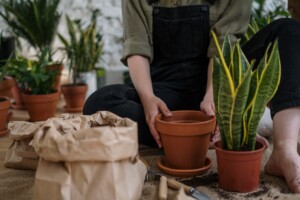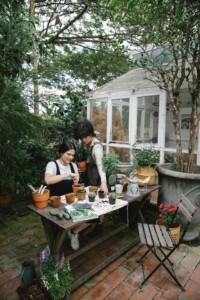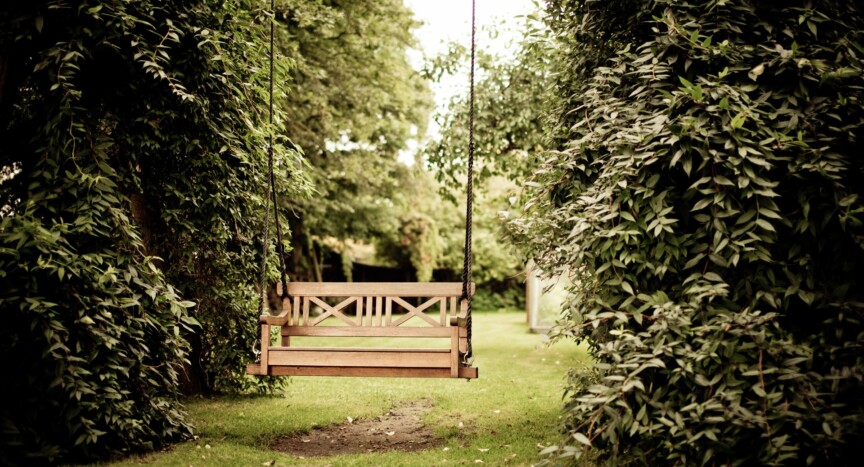According to the American Community Garden Association, “a community garden is somewhere people come together to grow plants and share the benefits of doing so.” [1]. At first sight, it seems to be a sufficient definition. However, after digging a little bit, community gardening appears to also have a lot of positive effects on health outcomes. In other words, being engaged in an association in one neighborhood increases health and well-being. Community organizations are a main component of a neighborhood [2] which can be defined as “a unique system of (health) relevant resources and social relationships embedded within geographical borders.”[2]. These kinds of organizations, and in this case community gardening, are a way to live a healthier life and to be happier, especially for certain groups of people.
A healthier way of living: no more Default American Lifestyle [3]
Participating in the growth of a community garden is a civic engagement which can help people to be in better physical health. This statement is particularly true for people with a lower-income living in a disadvantaged neighborhood. In fact, people who are gardening in their neighborhood have access to more fresh fruits and vegetables [4]. On the one hand, they can eat the fruits and vegetables they have cultivated and on the other hand, people participating in community garden activities are more likely to change their eating habits by buying more fresh food [4]. To quote a study [3] on the matter “Education is the key to good health.” By gardening with others, people have learned a lot about the link between food and health [5] and have, therefore, better eating habits. According to empirical findings, people who live in deprived neighborhoods and who are gardening in common gardens almost eat the number of fruits and vegetables recommended by the health authorities. This is not the case for those that live in the same neighborhood but that do not participate [4].
Another way gardening within a community can improve physical health is with bodily motion [5]. Gardening is an activity which induces flow. The state of flow is “the state in which people are so involved in an activity that nothing else seems to matter” [6]. By being completely immersed in an activity, people forget time and can garden for many hours thus exercising a lot, without noticing.
The Default American Lifestyle is characterized by a sedentary way of living and the consumption of processed food [3]. By participating in the growth of community gardens, people (and in particular low-income people) can reconsider their lifestyle and then get rid of the Default American Lifestyle or at least reduce it.
“Education is the key to good health.”[3]
More than a healthy body, a healthy mind!
Engaging in community garden activities helps people have a healthier mind, especially thanks to emplaced flow[1]. This concept is based on the classic definition of flow and adds the importance of the socio-spatial dimensions, in other words, this means that the place you are and the interactions you have while doing an activity are decisive in achieving flow. To be in the state of flow one has to feel comfortable thinking about nothing else than gardening [1]. Community gardening has therapeutic effects and helps people to reduce their depression, stress and anxiety so it enhances hedonic well-being [1]. Hence, being outside in a beautiful garden with other people while experiencing flow is a way to escape from real-life problems [1].
Community gardening can be a way to help out people with lower incomes, that experience stressful events daily more than people with higher incomes, and are therefore more subject to distress [7]. However, because of the compositional effect, disadvantaged people live in disadvantaged neighborhoods [2] in which there are disorders such as noise, dirt or people drinking alcohol in the streets [12]. All of these elements can scare people preventing them from going outside to meet their neighbors or to do exercise. Thus, the concept of emplaced flow is important to understand that even a garden can be a source of stress if it is surrounded by disorders [1] and the experience of flow is therefore impossible to reach. Consequently, people cannot increase their subjective well-being by gardening with their neighbors. Policies must be implemented to get rid of disorders.
No more loneliness: engaging in a community organization is a way to create bonds

Community engagement such as community gardening creates social cohesion and social capital [8]. When people go to the community garden, they are not alone but can meet people from their neighborhood with whom they share the same interests. By having something in common, people start to see each other outside the community garden and start being friends. Good social cohesion in a neighborhood increases people’s well-being because they feel good and safe with the people they live with, and they have the feeling they belong to a community. Moreover, by meeting their neighbors, people can create bonds and expand their social network, in other words, they can have more social capital [9]. This kind of capital facilitates “coordination and cooperation for mutual benefits” [10]. By knowing their neighbors, people can achieve goals they couldn’t reach without the help or the participation of others. For instance, my aunt was unemployed ten years ago and was looking for a job, which was difficult. But, after a few weeks of research, she asked her neighbor (who was also a friend of hers) for some help. Finally, she found a great job thanks to her neighbor who knew someone who wanted to hire a new accountant. In addition, neighborhood communities play a prominent role to change the institutional situation in the neighborhood and also the environment [2] by constructing, for example, new schools. When people meet in the community garden, they talk about their lives and consequently about their living area. They can see and feel the benefits of the garden in their lives and the neighborhood. Therefore, they start talking about new improvements that could be implemented in their area and they finally take action to change it. So, we can understand that community organizations increase people’s eudaimonic well-being because people feel a sense of powerfulness while changing things, and will also increase their hedonic well-being in the long run because they will live in a much better neighborhood through all the improvements they will have made.
By being engaged in community activities and the state of flow, people move their bodies, cure their stress and anxiety, have fun and meet people

It seems social cohesion and social capital would benefit low-income people the most [11]. However, poor people usually live in disadvantaged neighborhoods with a lot of disorders, therefore their level of trust is really low [12]. Indeed, “mistrust occurs when resources and opportunities are scarce; disorder, crime, threat and danger are common; and people feel powerless to avoid harm.”[12]. Without trust, it is difficult for people to be engaged in an organization within their neighborhood [11]. For example, if a woman is scared to go out because of the high rate of crimes in her neighborhood she would not engage in community gardening even though she would love to. Consequently, she would lack physical exercise and would lose the opportunity to create social links. Overall, her well-being and her health would be negatively impacted by the absence of engagement.
To conclude, gardening by yourself should no longer be the norm. By being engaged in community activities and the state of flow, people move their bodies, cure their stress and anxiety, have fun and meet people. Community gardening enhances health (physical and mental) and well-being (hedonic and eudaimonic) and this activity is even more useful for people with a lower income.
Referenties
[1] Pitt H. (2014). Therapeutic experiences of community gardens: putting flow in its place. Health & Place. P.84-91.
[2] Bernard, P., R. Charafeddine, K. Frohlich, M. Daniel, Y. Kestens, and L. Potvin. (2007). “Health inequalities and place: A theoretical conception of neighborhood.” Social Science & Medicine 65:1839–1852.
[3] Mirowsky, J., & Ross, C. (2015). Education, Health, and the Default American Lifestyle. Journal of Health and Social Behavior. doi:10.1177/0022146515594814
[4] Martin P., Consalès J-N., Scheromm P., Marchand P. ; Ghestem F., Darmon N. (2017). Community gardening in poor neighborhoods in France: a way to re-think food practices? Appetite.
[5] Lovell R., Husk K., Bethel A., Garside R. (2014). What are the health and well-being impacts of community gardening for adults and children: a mixed method systematic review protocol. Environmental evidence.
[6] Csikszentmihalyi, M. (1990). Flow : the psychology of optimal experience. New York. Harper & Row.
[7] Thoits, P. (1995). Stress, coping, and social support processes: where are we? What next?. Journal of Health and Social Behavior.
[8] O’Mara-Eves, A., Brunton G., Oliver S., Kavanagh J., Jamal F., Thomas J. (2015). The effectiveness of community engagement in public health interventions for disadvantaged groups: a meta-analysis. BMC Public Health.
[9] Putnam R. (1993). Making democracy work: civic traditions in modern Italy.
[10] Putnam R. (1995). Bowling alone: America’s declining social capital.
[11] Lo lacono, S., Sonmez B. (2020). The effect of trusting and trustworthy environments on the provision of public goods. European sociological review. 155-168.
[12] Ross, C., J. Mirowsky, and S. Pribesch. (2001). “Powerlessness and the amplification of threat: Neighborhood disadvantage, disorder, and mistrust.” American Sociological Review 66:568-591.







